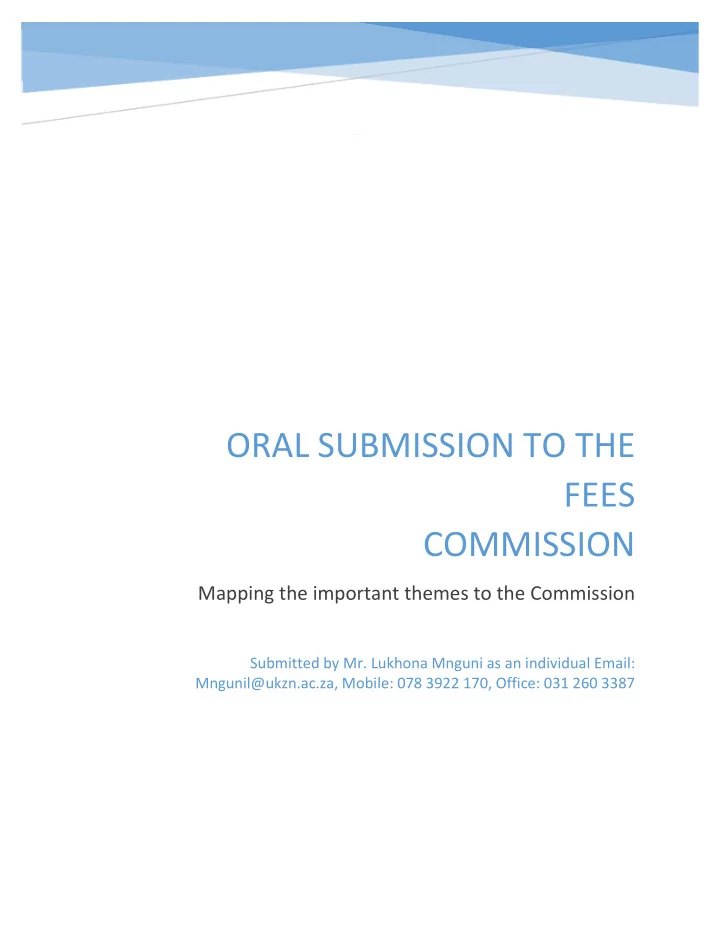

ORAL SUBMISSION TO THE FEES COMMISSION Mapping the important themes to the Commission Submitted by Mr. Lukhona Mnguni as an individual Email: Mngunil@ukzn.ac.za, Mobile: 078 3922 170, Office: 031 260 3387
Embargoed until 29 August 2016, 12:00pm. Contents Introduction ............................................................................................... 2 Participation Rates ..................................................................................... 3 How do we determine the threshold on who is poor? ............................... 4 Endowments .............................................................................................. 6 Quality of Tutorship .................................................................................. 8 1
Embargoed until 29 August 2016, 12:00pm. Introduction This commission serves a historic moment in the development trajectory of our country. The cries of society now rest with this commission. Through its work, conclusions and the actioning thereof the commission will ensure restoration of stability and productivity in Institutions of Higher Learning or further instability, revolutionary pursuits and compromised productivity. Broadly read, the Terms of Reference for the commission are straight forward. You are asked to determine “the feasibility of making higher education and training (higher education) fee -free in South Africa”. The three subsections that follow only serve to guide, but not limit, the scope of your inquiry. Thus, for me, feasibility extends beyond the financial viability test – determined by government’s ability to afford allocating funds to substitute tuition fees. Maybe I will touch on how government funding can be sourced for this to be achieved, but mainly I am going to move from the premise that progressively acquired fee-free higher education and training is attainable. By ‘progressively acquired’ I mean this country can afford to put a timeline towards the attainment of fee-free education for all, integrating the entire student body gradually, starting with the most needy as early as 2018. During my presentation I will discuss the difficulty in defining ‘the most needy’ students. I will not dwell on academic freedom and how it is affected by sources of funding. This is because, for me, academic freedom depends on the vigilance, ethical conduct, truthfulness, decisiveness and commitment to freedom of those who lead and occupy space within the academy hierarchy. I have witnessed academics frustrate academic freedom, not because of where funding for their institutions comes from but merely to advance their own greed and egotism, worse at times due to shortsighted leadership. Society must remain vigilant and committed to ensure academic freedom thrives, irrespective of sources of funding for the sector. Therefore, for me, feasibility must look at formulating a desirable higher education and training system, devoid of: - high student attrition rates, - over saturation of students in some institutions, - low staff retention ability, - horrific living conditions for students, - low participation of women in postgraduate studies compared to their participation in undergraduate, and - decent working conditions for academics and support staff due to over saturation in some institutions. 2
Embargoed until 29 August 2016, 12:00pm. This list is not exhaustive. The point I am trying to communicate here is that the work of the commission cannot ask a narrow question that says, “How much is the portion of Universities’ budgets that is made up of tuition fees and can government afford it ?” This is the wrong question to ask and this is because, for the system to function efficiently, effectively, responsively and sustainably more funding is needed than the current figures. Therefore, when some in society like the South African Institute of Race Relations 1 say “ If higher education was to be funded solely through taxpayer subsidies then a further R71-billion, over and above the existing R25-billion, would be necessary. Our analysis suggests that, with sufficient prioritising, that R71-billion could be raised”. However, this constrains itself to today’s figures. Our higher education and training system is under resourced, it has the problems I have outlined above and the current University budgets need massive expansion to create intellectual bridges for students who are underprepared by the current basic education system. In bold truth, the current higher education and training system is designed for failure, with high attrition rates that would make the fee-free higher education and training venture not yield any value for money or return on investment. We must budget for a funding model that will repair this ailing sector and set it on a good path of success. For this presentation I will concern myself with four key issues that are important to ponder on if we are to have a truly reflective report on the task to investigate fee-free education. These are 1) Participation rates, 2) Endowments 3) How do we determine the threshold on who is poor? and 4) Quality of instruction. Participation Rates The discussion on fee-free higher education and training is being held during a period of low participation rates. Our feasibility study must envisage a need for increased participation and thus propose a funding model that is futuristic and sustainable precisely for the achievement of increased participation. The National Development Plan (NDP) has a set target of annual enrolment levels reaching 1.6 million students by 2030 2 . According to the latest figures, published in January 2016, by the Council on Higher Education 3 indicates that the participation rate in 2012 stood at 19% and this was an increase from 17% in 2011. There is a long way to go. Participation rate is calculated, by CHE, as “the total headcount enrolments [in public HE institutions] as a percentage of the total population between the ages of 20 – 24 years.” There is of course something amiss here given that many of our first and second year students are below 20 years. 1 Phungo, R. (2015). “ University fees: Free higher education is possible in South Africa ”. Daily Maverick, 21 Oct 2015: http://www.dailymaverick.co.za/article/2015-10-21-university-fees-free-higher-education-is-possible-in- south-africa/#.V79DBqItjQ9 2 http://www.pwc.co.za/en/higher-education/Funding-public-higher-education-institutions-SA.html 3 http://www.che.ac.za/focus_areas/higher_education_data/2013/participation 3
Recommend
More recommend